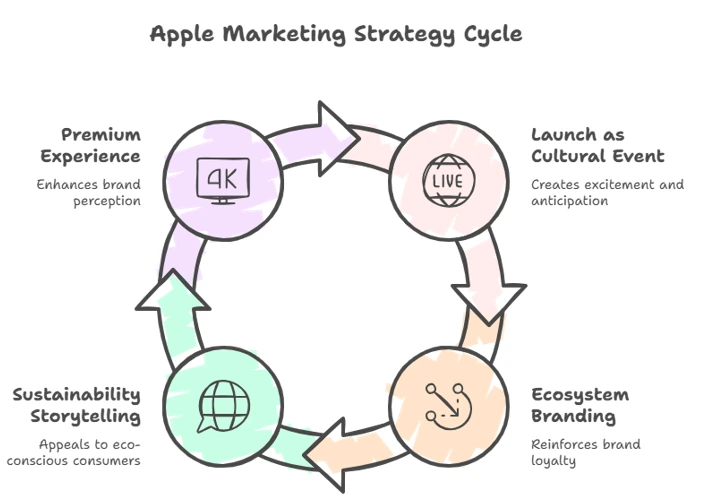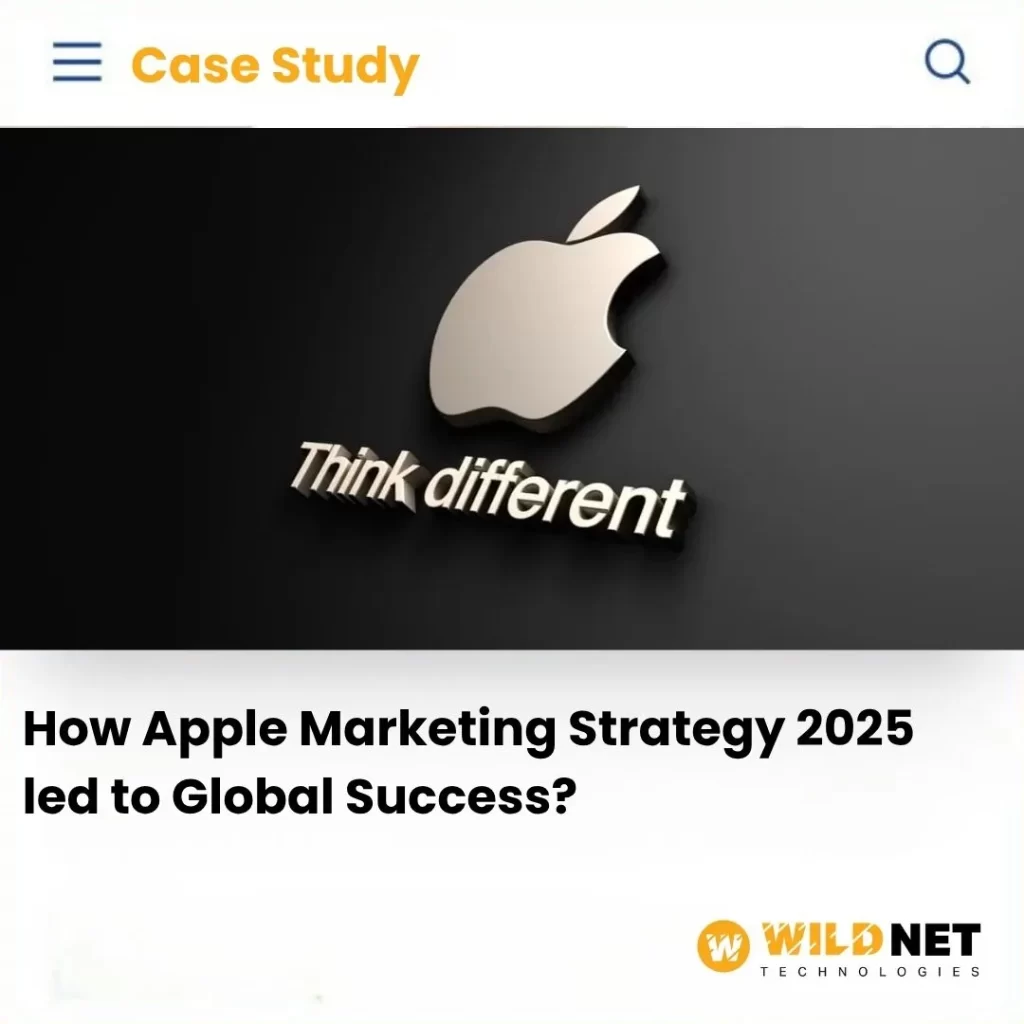Summary
Apple’s unique marketing playbook is responsible for its ability to maintain global dominance. This case study explores how Apple’s marketing strategy 2025 elevated brand loyalty, drove innovation-led campaigns, and positioned Apple as a global success story.
By analyzing challenges, solutions, and best practices, this case study provides actionable lessons for brands aiming to replicate Apple’s brilliance.If you are wondering about what is apple marketing strategy, apple vs samsung case study or more, Wildnet has you covered.
Introduction
The Apple marketing strategy has been studied for decades, admired for its simplicity, emotional resonance, and premium positioning.
But in 2025, Apple sharpened its approach even further. From integrating AI-powered personalization to expanding its ecosystem of devices and services, Apple demonstrated how powerful marketing can fuel growth even in saturated markets.
This case study of Apple company explains how innovation in storytelling, brand consistency, and user-centric campaigns created global impact. We also explore what marketing strategy does Apple use, why it works, and what lessons marketers & brands can adopt from it.
Apple Marketing Strategy 2025
The marketing strategy of Apple has always been rooted in minimalism, exclusivity, and emotional connection. In 2025, however, the company combined these elements with digital-first campaigns and AI-driven personalization.

Apple Marketing Strategy in 2025: Four Steps
Key highlights of Apple marketing strategy 2025 include:
This Apple marketing strategy analysis highlights that Apple never sells just products—it sells a lifestyle and a sense of belonging.
- Product Launches as Cultural Events: Apple’s September 2025 iPhone 17 launch was live-streamed to over 20 million viewers globally, framing it as a lifestyle milestone rather than a tech release.
- Ecosystem Branding: Apple devices and services were marketed not as standalone products but as an interconnected ecosystem, increasing customer retention.
- Sustainability Storytelling: Apple used its tagline “Carbon Neutral by Design” to resonate with eco-conscious consumers.
- Premium Experience through Simplicity: Marketing campaigns avoided clutter, focusing on sleek visuals and aspirational storytelling.
Business Overview
Founded in 1976, Apple Inc. has become one of the world’s most valuable companies by blending design, innovation, and marketing excellence. In 2025, its market capitalization surpassed $3.78 trillion, largely due to its dominance in services, wearables, and premium smartphones.
The marketing strategy of Apple company consistently emphasizes exclusivity & user experience, which differentiates Apple from rivals like Samsung and Google. Instead of competing on specifications, Apple competes on brand equity and emotional engagement.
Challenges Faced
Despite success, Apple faced significant challenges in 2025:
Market Saturation
With smartphone penetration reaching maturity globally, Apple had to convince customers to upgrade despite incremental innovation—and pay a hefty sum, too.
Competition from Samsung & Chinese Brands
Rival companies offered advanced features at lower prices (AI, folding, and much more), intensifying competition.
Sustainability Pressure
Environmental activists pushed Apple to prove a genuine commitment to climate goals, not just greenwashing. This was a tough nut to crack.
Privacy Concerns
With AI integration, users questioned how their data was used for personalization, which was attacking Apple’s safe phone image.
Post-COVID Consumer Behaviour
A shift toward value-driven purchases made Apple’s premium pricing challenging in specific markets.
Being one of the tech leaders, they handled it all gracefully and solved them individually.
Solutions
They tackled these challenges with bold moves via Apple company marketing strategy:
Lifestyle Branding
Instead of selling features, Apple marketed devices as gateways to creativity, productivity, and self-expression. This ensured that people bought their devices not as accessories but as life choices.
AI-Powered Personalization
Campaigns delivered tailored product suggestions and ads powered by predictive AI tools. Because to stay fresh, you must project a fresh image while carrying out the legacy. Apple’s tagline in 2025, “Sleek Peek,” aptly defines their product line, which is the epitome of sleek tech.
Transparent Sustainability Campaigns
Apple highlighted sustainability via carbon-neutral facilities, recycled materials, and its tagline “Designed for a Better Tomorrow.” This is enough to silence the haters and attract more clientele.
Service Ecosystem Growth
Apple Music, Fitness+, and iCloud were marketed alongside devices, ensuring recurring revenue. Because, as they have clarified earlier, not a phone but a lifestyle is what you (users) can get once you are part of the Apple family.
In summation, more business and user retention.
Selective Regional Pricing
Apple adapted its pricing and financing models in markets like India to remain competitive while sustaining brand value. They even launched a saffron-coloured phone, ensuring maximum sales within India.These solutions proved that Apple marketing is as much aboutstorytelling as technology.
Apple Marketing Strategy 2025: Lessons for Brands & Marketers
Now that we have decoded the Apple marketing strategy, let’s refine it further and help brands & marketers to shine in 2025.
Best Practices
Start by implementing these best practices to upgrade your marketing campaigns.
- Focus on simplicity in messaging—clarity wins over complexity.
- Build an ecosystem, not just products, to increase long-term customer loyalty.
- Leverage storytelling and emotions instead of feature-heavy promotion.
As you can see in these three pointers, user-friendliness starts with simplicity.
Common Mistakes to Avoid & their Solutions
To be a Pro, you must avoid a few things.
Mistake 1
Copying Apple without understanding its culture.
Solution -> Adapt and customize strategies authentically as per your brand’s values.
Mistake 2
Over-relying on technical specs.
Solution -> Market benefits, not just features.
In other words, copy like a boss and always talk about benefits first.
Key Metrics to Track
Here are the key metrics or KPIs to track and match them with Apple’s.
- Customer Lifetime Value (CLV) from the Apple ecosystem.
- Engagement rate on Apple advertising campaigns.
- Market share growth in premium segments.
- Sentiment analysis across social platforms.
Only by comparing with the great can your brand/client become greater.
AI Tools to Leverage
AIs are unavoidable, and here are three AIs that a tech brand cannot skip.
- Predictive analytics platforms for consumer behaviour forecasting, such as SAS Viya, IBM Watson Studio & more.
- AI-driven content creation tools for targeted ads such as AdGPT, Jasper & more.
- Personalization engines for tailored customer journeys via Optimizely, Salesforce Marketing Cloud & more.
With these AI tools, key metrics, common mistakes to avoid, and best practices, your brand or client will be the highlight in 2026.All you need is an AI marketing agency partner…
Conclusion
The Apple marketing strategy in 2025 reinforced Apple’s position as a global leader.
By embracing sustainability, storytelling, and AI-driven personalization, Apple demonstrated that marketing isn’t just about selling products—it’s about shaping culture. For brands worldwide, this case study of Apple company shows that success comes from aligning marketing with values, experiences, and long-term customer trust.


